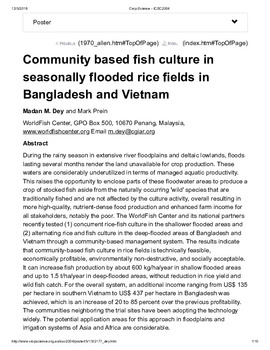Community based fish culture in seasonally flooded rice fields in Bangladesh and Vietnam

Citation
Dey, M.M.; Prein, M. (2004). Community based fish culture in seasonally flooded rice fields in Bangladesh and Vietnam. Proceedings of the 4th International Crop Science Congress "New Directions for a Diverse Planet", 26 September to 1 October 2004, Brisbane, Australia (on CDROM). 5 p.
During the rainy season in extensive river floodplains and deltaic lowlands, floods lasting several months render the land unavailable for crop production. These waters are considerably underutilized in terms of managed aquatic productivity. This raises the opportunity to enclose parts of these floodwater areas to produce a crop of stocked fish aside from the naturally occurring 'wild' species that are traditionally fished and are not affected by the culture activity, overall resulting in more high-quality, nutrient-dense food production and enhanced farm income for all stakeholders, notably the poor. The WorldFish Center and its national partners recently tested (1) concurrent rice-fish culture in the shallower flooded areas and (2) alternating rice and fish culture in the deep-flooded areas of Bangladesh and Vietnam through a community-based management system. The results indicate that community-based fish culture in rice fields is technically feasible, economically profitable, environmentally non-destructive, and socially acceptable. It can increase fish production by about 600 kg/ha/year in shallow flooded areas and up to 1.5 t/ha/year in deep-flooded areas, without reduction in rice yield and wild fish catch. For the overall system, an additional income ranging from US$ 135 per hectare in southern Vietnam to US$ 437 per hectare in Bangladesh was achieved, which is an increase of 20 to 85 percent over the previous profitability. The communities neighboring the trial sites have been adopting the technology widely. The potential application areas for this approach in floodplains and irrigation systems of Asia and Africa are considerable.
Permalink
Date Available
Countries
Research Themes
Topics
Language